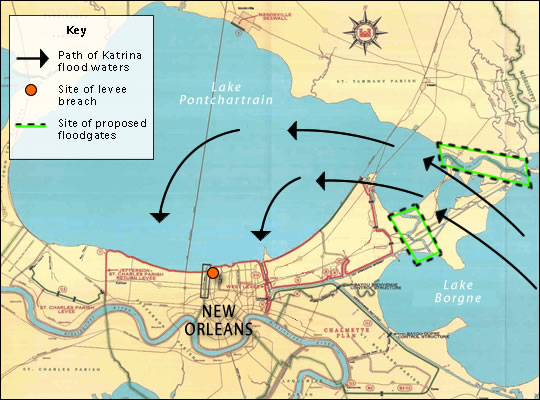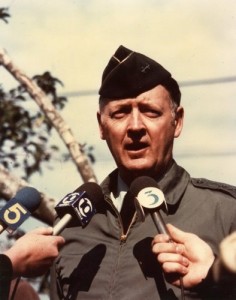Former Head of Army Corps of Engineers Regretted Not Fighting for Storm-Surge Gates
As Tropical Storm Karen approaches the Gulf Coast, and FEMA employees, furloughed by the latest GOP Government Shutdown, are called back to work without pay, The New York Times reports the death of Lt. Gen. Elvin R. Heiberg III, “who rose to the top of the United States Army Corps of Engineers in the 1980s and decades later expressed regret for failing to fight hard enough to build floodgates that he believed might have protected New Orleans from Hurricane Katrina.” Gen. Heiberg died last Friday, Sept. 27, in Arlington, Va. He was 81.
In June 2007, the Times reports, “nearly two years after Katrina, General Heiberg wrote a letter published in The Times-Picayune of New Orleans that ‘As too many continue to rush around to find someone to blame for the Katrina engineering failures, they can blame me. I gave up too easily.’ ”
After Hurricane Betsy in 1965, the U.S. Army Corps of Engineers conceived a plan to build flood-surge gates at the eastern edge of Lake Pontchartrain at the Chef Menteur and the Rigolets passes to be lowered in case of an oncoming hurricane (map below). Environmentalists worried that the presence of the floodgates would make it easier for developers to drain areas for development and that the flow of water would be blocked.Luke Fontana, executive attorney for Save Our Wetlands Inc., filed a lawsuit to block the floodgates. In 1985, twenty years after Hurricane Betsy, the Corps gave up the plan. (The plan and its defeat—“death-by-environmentalism,” we call it—is discussed in detail in Mark Schleifstein and John McQuaid’s excellent 2006 book Path of Destruction: The Devastation of New Orleans and the Coming Age of Superstorms. See our interview with Schleifstein here.)
In an interview cited by NPR online, Gen. Heiberg said, “I think that’s probably the biggest mistake I made, quitting instead of fighting. . . . I think Katrina proved that.” (See “Why Did the 17th Street Canal Levee Fail?” NPR, May 19, 2006.)

The New York Times obituary in full appears below.
Elvin R. Heiberg III, General Who Took Blame for Hurricane Katrina Failures, Dies at 81
Lt. Gen. Elvin R. Heiberg III, who rose to the top of the United States Army Corps of Engineers in the 1980s and decades later expressed regret for failing to fight hard enough to build floodgates that he believed might have protected New Orleans from Hurricane Katrina, died last Friday in Arlington, Va. He was 81.
The cause was cancer, said his daughter Kay Bransford.
In June 2007, nearly two years after Katrina, General Heiberg wrote a letter published in The Times-Picayune of New Orleans that read: “As too many continue to rush around to find someone to blame for the Katrina engineering failures, they can blame me. I gave up too easily.”
He explained that in the 1970s, when he commanded the New Orleans district, the corps planned to protect the city by building gates at the east end of Lake Pontchartrain. Environmentalists opposed the project, and local interests objected to sharing the costs, as federal law requires. A federal judge blocked the project and called for a more thorough analysis of its environmental impact.
In the 1980s, when General Heiberg was commander of the corps, or chief of engineers—the youngest man to head the corps since the 19th century—the fight over the so-called barrier plan was still going on. “I was discouraged and decided to stop fighting for the barriers any longer,” he wrote in The Times-Picayune. “In retrospect, that was the biggest mistake I made during my 35 years as an Army officer.”
In lieu of the barrier, the corps turned to raising levees and floodwalls around the city. It turned out to be a patchwork project that was still not complete when Katrina hit 20 years later and many segments of the floodwall failed. The official corps report on the disaster called the hurricane protection system “a system in name only.”
General Heiberg’s letter fed an argument that had begun circulating soon after the storm that had blamed environmentalists for the destruction of the city, accusing them of blocking efforts to protect it. The conservative FrontPage Magazine called their tactics “Green Genocide.”
But the barrier envisioned by the corps would have been ineffective, said G. Paul Kemp, an author of Louisiana’s official report on the disaster and an adjunct professor at the Louisiana State University department of oceanography and coastal sciences. Much of the water that inundated New Orleans, he said, had flowed in from a corner of Lake Borgne, which lies to the south and east of the city and which would have been outside the barrier’s reach.
Alfred Naomi, a former senior project engineer for the corps in New Orleans, agreed that the barriers “might not have made a difference for Katrina,” though he argued that some areas might have suffered less damage had the barriers been there and that the project would have improved safety overall. He expressed admiration for General Heiberg and his public stand. “That showed integrity and moral certitude that you don’t find a lot in today’s society,” he said. “Right or wrong, he took the hit — and took some responsibility.”
Elvin Ragnvald Heiberg III—he went by “Vald”—was born on March 2, 1932, at Schofield Barracks, the Army installation on the island of Oahu in Hawaii. Like his father and a grandfather, he joined the Army and attended the United States Military Academy at West Point; the grandfather served as military attaché in Rome and died when he was thrown by a horse while visiting the Austro-Hungarian front in 1917.
Vald III graduated from West Point in 1953 and earned master’s degrees from the Massachusetts Institute of Technology and George Washington University.
His career in the Army and Corps of Engineers took him to wartime service in Korea and Vietnam and to Saudi Arabia, where he oversaw $14 billion in corps-led construction projects for the country’s national guard. He led the corps’ cleanup and rebuilding effort after the eruption of Mount St. Helens in Washington State in 1980, and ran the Army’s Ballistic Missile Defense Program, a precursor to the Reagan administration’s “Star Wars” plan.
General Heiberg’s many decorations included the Silver Star Medal, the Legion of Merit and the Distinguished Flying Cross from his Vietnam service; he twice earned the Distinguished Service Medal.
After retiring from the military, he worked with a number of companies, including Dawson & Associates, a consulting and government relations firm with expertise in water resources, where he was a senior adviser.
In addition to Ms. Bransford, General Heiberg’s survivors include his wife, the former Kathryn Schrimpf, whom he married in 1953; another daughter, Kathryn Heiberg-Browning; two sons, Walter and Elvin IV; and a sister, Dorethe Skidmore.
Contacted by a reporter last year to discuss the old barrier plan, General Heiberg said, “I haven’t changed my mind on any of that.”
New Orleans is now protected by a $14 billion ring of walls, levees and gates, including a two-mile barrier at the northwest corner of Lake Borgne, and gates that can close the city’s drainage canals to block any surge from Lake Pontchartrain. Barriers for Lake Pontchartrain are again under consideration.
#


